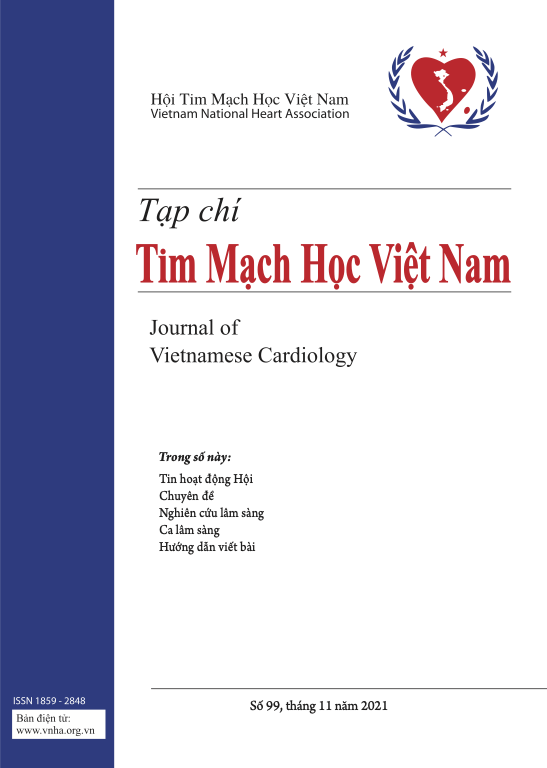Tỷ lệ suy tim và tái nhập viện sau ghép tim ở người bệnh tại Bệnh viện Hữu Nghị Việt Đức
Tóm tắt
Mục tiêu: Suy tim là nguyên nhân hàng đầu gây tử vong sau ghép tim, do suy tạng ghép hoặc thải ghép gây nên. Nghiên cứu này nhằm đánh giá tỷ lệ suy tim và tái nhập viện vì suy tim ở nhóm bệnh nhân sau ghép tim tại Bệnh viện Hữu Nghị Việt Đức. Đối tượng và phương pháp: Từ 14/04/2011 đến 14/09/2022, 45 bệnh nhân được tiến hành ghép tim đồng loài tại Bệnh viện Hữu Nghị Việt Đức, nghiên cứu cắt ngang và hồi cứu để xác định tỷ
lệ suy tim và tái nhập viện.
Kết quả: 45 bệnh nhân với độ tuổi trung bình tại thời điểm ghép tim 39,7 ± 15,7 tuổi, người cho nhỏ tuổi nhất là 14 tuổi, người cho lớn tuổi nhất là 56 tuổi, giới nam chiếm nhiều hơn (77,8%), bệnh lý nền dẫn đến ghép tim là bệnh cơ tim giãn (chiếm 77,8%). Có 10/45 bệnh nhân tử vong sau ghép tim, trong đó 7 bệnh nhân có nguyên nhân suy tim dẫn đến tử vong. Có 16/35 (45,7%) bệnh nhân còn sống có suy tim phân suất tống máu bảo tồn. Có 2/35 (5,7%) bệnh nhân suy tim giai đoạn B, 14/35 (40%) bệnh nhân giai đoạn C. Có 7/35 (15,5%) bệnh nhân có tái nhập viện vì suy tim, trong khi không có bệnh nhân nào tái nhập viện vì suy tim ở nhóm bệnh nhân ghép tim còn sống.
Kết luận: Ghép tim là biện pháp điều trị cuối
Tài liệu tham khảo
1. Cruz C, Hajjar LA, Bacal F, et al. Usefulness of speckle tracking echocardiography and biomarkers for detecting acute cellular rejection after heart transplantation. Cardiovasc Ultrasound. Jan 9 2021;19(1):6. doi:10.1186/s12947-020-00235-w
![]()
2. Shah KS, Kittleson MM, Kobashigawa JA. Updates on Heart Transplantation. Curr Heart Fail Rep. Oct 2019;16(5):150-156. doi:10.1007/s11897-019-00432-3
![]()
3. Khush KK, Hsich E, Potena L, et al. The International Thoracic Organ Transplant Registry of the International Society for Heart and Lung Transplantation: Thirty-eighth adult heart transplantation report - 2021; Focus on recipient characteristics. J Heart Lung Transplant. Oct 2021;40(10):1035-1049. doi:10.1016/j.healun.2021.07.015
![]()
4. Sun YF, Wang ZW, Zhang J, Cai J, Shi F, Dong NG. Current Status of and Opinions on Heart Transplantation in China. Curr Med Sci. Oct 2021;41(5):841-846. doi:10.1007/s11596-021-2444-9
![]()
5. Vega E, Schroder J, Nicoara A. Postoperative management of heart transplantation patients. Best Pract Res Clin Anaesthesiol. Jun 2017;31(2):201-213. doi:10.1016/j.bpa.2017.06.002
![]()
6. Grupper A, Gewirtz H, Kushwaha S. Reinnervation post-heart transplantation. Eur Heart J. May 21 2018;39(20):1799-1806. doi:10.1093/eurheartj/ehw604
![]()
7. Singh SSA, Dalzell JR, Berry C, Al-Attar N. Primary graft dysfunction after heart transplantation: a thorn amongst the roses. Heart Fail Rev. Sep 2019;24(5):805-820. doi:10.1007/s10741-019-09794-1
![]()
8. Sirri L, Tossani E, Potena L, Masetti M, Grandi S. Manifestations of health anxiety in patients with heart transplant. Heart Lung. Jul - Aug 2020;49(4):364-369. doi:10.1016/j.hrtlng.2019.12.006
![]()
9. Lopez-Sainz A, Barge-Caballero E, Barge-Caballero G, et al. Late graft failure in heart transplant recipients: incidence, risk factors and clinical outcomes. Eur J Heart Fail. Feb 2018;20(2):385-394. doi:10.1002/ ejhf.886
![]()
10. Wever-Pinzon O, Edwards LB, Taylor DO, et al. Association of recipient ageand causes of heart transplant mortality: Implications for personalization of post-transplant management-An analysis of the International Society for Heart and Lung Transplantation Registry. J Heart Lung Transplant. Apr 2017;36(4):407-417. doi:10.1016/j.healun.2016.08.008
![]()








